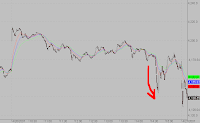Pivot point calculations are used by security traders to attempt to predict support and resistance levels which are, in turn, used as visual cues to execute trades. These calculations provide traders with objective visual bench marks which some use to predict price changes. They are commonly used in the forex and commodity futures markets. Pivot point analysis is a subset of technical analysis, although it is not as popular or well known as other technical methods.
Some traders believe that there are two prevailing tendencies in price movements. If a day's price action begins above the pivot point, prices will tend to stay above that point (fulcrum) until it reaches a resistance point. Conversely, if a day's price action begins below the pivot point, the price will tend to stay below that point until it reaches a support point. A resistance level is a price that tends to prevent further upward movement. A support price is a price action point that tends to prevent further downward movement.
Typically such a trader, when price approaches a pivot above, waits for a reversal at that point and sells. The opposite is true when price action is moving downward, the pivot trader waits for a bounce off the pivot of support and places an order to buy.
The rationale of this is an attempt to avoid buying high (at R2) or selling at the low (S2).
This strategy may not be supported by most technical watchers but is amongst one that is in some use.
Pivots are used to project potential support and resistance levels. The main time periods used are daily, weekly, and monthly pivots. The formula for the daily pivot point, support, and resistance is shown below:
- Pivot Point = [Yesterday's High + Yesterday's Low + Yesterday's Close] / 3
Support Levels
- S1 = [Pivot Point * 2] - Yesterday's High
- S2 = Pivot Point - Yesterday's High + Yesterday's Low
- S3 = S2 - Yesterday's High + Yesterday's Low
Resistance Levels
- R1 = [Pivot Point * 2] - Yesterday's Low
- R2 = Pivot Point + Yesterday's High - Yesterday's Low
- R3 = R2 + Yesterday's High - Yesterday's Low
To calculate weekly or monthly numbers, simply replace "yesterday's" with "last week's" or "last month's" high or low.
A 5-minute chart and the corresponding pivots are shown below:

In the chart above, and going from left to right, Resistance Level 1 (R1) held and the price reversed course and headed downward.
After that, the next potential support was at the Pivot Point. However, the price broke through the Pivot Point. Notice that when the stock attempted to reverse course, it was rejected by the Pivot Point now acting as resistance. An important technical analysis concept is that when resistance is penetrated the prior resistance then becomes support. Similarly, when support is penetrated the prior support then becomes resistance.
From there, the next support was Support Level 1 (S1). S1 held strong and the stock reversed direction yet again.
The next resistance line was at the Pivot Point, which failed.
The trading day ended by the stock testing the Pivot Point, now acting as support, which subsequently held. From there, the index rallied on into the close.
In addition to giving buy and sell signals, Pivots give traders a good time to get out of their trade. To illustrate, during a rally some traders will set their sell orders right below the next resistance line. Thus, pivot point resistance and support lines can generate ready made profit targets.

In the 5-minute chart of another example, the stock opened the day downward, but held steady at Support 2 (S2).
From there, the price rallied past S1 and the Pivot Point. Eventually, the price found resistance at Resistance 1 (R1).
Next, the Pivot Point offered support initially, but then the stock meandered slightly above and below the pivot point, until finally, the stock accelerated past R1 and then past R2.
The rally continued until one candlestick reached R3, where the bulls were promptly rejected.
........................... Click here to read more!

















